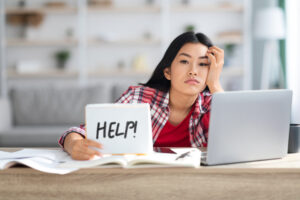Dear Dr. Sharon: How Can I Help Child with ADHD Feel More Calm and Confident??
Navigating the ADHD-Anxiety Cycle: How to Help Your Child Feel Calm and Confident
Dear Dr. Sharon,
My 13-year-old daughter has ADHD and takes Concerta but lately she’s been getting really anxious about school—especially homework and tests. She says she ‘can’t do it,’ even when I know she’s capable. She’ll melt down or shut down completely. How can I tell what is ADHD and what is anxiety? What can I do to help her?
-Terrence
Dear Terrence-
You have raised an important question. When you are raising a child or teen with ADHD and anxiety, it’s tough to know which is one or the other and how you can best help. Distraction turns into overwhelm, which turns into worry, which
 spirals into shutdown or meltdowns. It’s not only heartbreaking to watch but also exhausting for everybody involved. I’m going to explain the big aspects here but please check out my other blogs, articles , and podcasts on this topic.
spirals into shutdown or meltdowns. It’s not only heartbreaking to watch but also exhausting for everybody involved. I’m going to explain the big aspects here but please check out my other blogs, articles , and podcasts on this topic.
Despite misdiagnoses, ADHD differs significantly from anxiety. While kids with ADHD wrestle with organization, working memory challenges, impulse control, kids with anxiety struggle with compulsive, obsessive or perfectionistic behaviors, psychosomatic ailments and debilitating specific phobias. Issues related to food, housing or job insecurity, systemic racism or trauma further intensify anxiety.
UNDERSTANDING THE ADHD-ANXIETY CONNECTION IN KIDS
Recent research shows that around 10% of children ages 3-17 had current, diagnosed anxiety. The co-occurrence of anxiety with ADHD is shockingly higher–39%, often due to a combination of neurobiology, executive functioning challenges and environmental issues. Many youngsters ADHD miss visual or auditory cues, misread facial expressions and wrestle with effective communication, resulting in social anxiety and rejection sensitivity. Their concerns about ‘messing up again’ amp up into persistent worry about the next time that they will (unwittingly) make a mistake or forget something important. That anxiety, in turn, makes it even harder for them to focus, think clearly, or try new things—feeding right back into their ADHD symptoms.
ADHD vs ANXIETY – WHAT’S THE DIFFERENCE?
ADHD is primarily a condition of self-regulation and self-awareness (metacognition) challenges. Anxiety refers to persistent distress, unease or fear in situations regardless of them being benign or dangerous. The danger can be  perceived even if it isn’t there to someone else. ADHD and anxiety share some symptoms which can make them seem similar: difficulty with concentration, distractibility, trouble relaxing and feeling restless. In order to separate them for your daughter, it’s useful to observe how often she is anxious, reflect on whether anxiety runs in your family and ask if there a consistent trigger for episodes of worry or emotional outbursts.
perceived even if it isn’t there to someone else. ADHD and anxiety share some symptoms which can make them seem similar: difficulty with concentration, distractibility, trouble relaxing and feeling restless. In order to separate them for your daughter, it’s useful to observe how often she is anxious, reflect on whether anxiety runs in your family and ask if there a consistent trigger for episodes of worry or emotional outbursts.
SIGNS YOUR DAUGHTER MIGHT BE CAUGHT IN AN ADHD-ANXIETY LOOP
You mention that your daughter is having trouble with her homework, losing her temper and shutting down. These behaviors are clear signs that she’s stuck in this ADHD-anxiety cycle. Common symptoms include:
-Meltdowns before or after school
-Avoidance of homework or new activities
-Frequent “I can’t do it!” or “I’m dumb” comments
-Difficulty falling asleep due to worry
-Physical complaints (like stomach or head aches) related to stress
As her father, it’s important to understand the difference between nervousness, worry and anxiety. While nervousness goes away once a skill has been mastered, anxiety can take over somebody’s daily life experiences. When this happens, it’s critical to speak to a primary care provider and find a therapist.
Worry, however, differs from anxiety. Worry refers to how we think about something. Anxiety is our physiological response based on negative thoughts and distorted beliefs. We cannot eliminate anxiety: it’s a natural human response that’s evolved for survival. Without useful self-management strategies and unable to access the internal resources they need, anxious kids like your daughter tend to catastrophize, freak out or become stuck. She can’t think beyond the extreme worry of the moment and needs tools to tolerate uncertainty and the possibility of disappointment.
4 STRATEGIES TO HELP YOUR ANXIOUS CHILD BUILD CONFIDENCE
Instead of reassuring her that everything will be okay (you can’t actually guarantee that), use these four strategies to help her learn to manage anxiety, increase calm and build confidence:
1. Manage your own concerns first: Children and teens easily pick up when their parents are stressed or anxious and it increases their own distress. The first step is to lower your own anxiety. Discuss your concerns with your partner, a friend, extended family member or counselor. Brainstorm ways that you can manage your feelings and strategize steps to slow down your reactivity and gain a sense of personal control. When you learn to slow yourself down, you can share some of your tricks with her: breathing techniques, taking a walk or squeezing a stress ball.
2. Validate and coach: Instead of jumping in to fix things right away, start by acknowledging her feelings: “It sounds like you’re feeling really overwhelmed right now. That makes sense—it’s a lot to deal with.” Validation helps kids feel seen and understood, which calms their nervous system and opens the door to problem-solving. Speak slowly with neutral volume and offer support instead of solutions. Try saying: “I’m here with you. Let’s figure this out together.” This shows her that she is not alone and you aren’t telling her what to do. You are working with her.
3. Create Predictable Routines: Kids with ADHD and anxiety thrive with structure—it helps reduce uncertainty, which triggers most anxiety. Routines also foster those all-important executive functioning skills. Use visual schedules for mornings and evenings. Offer warnings before transitions and use timers or alarms. Break large tasks (like getting ready for school or doing homework) into simple, step-by-step directions. Together, create checklists (with no more than three items) to post in the kitchen or her bedroom to reduce overwhelm. Lastly, let her choose the order of the tasks she has to do to increase her buy-in and her sense of autonomy.
4. Focus on Effort More Than Outcome: Confidence grows when kids feel successful—especially after trying something hard. Anxiety is great at erasing memories of past successes. Choose goals collaboratively that are within reach. Then break these down into small, doable steps. Recall times when she took a risk and succeeded. How can she apply those strategies to this situation? Lastly, celebrate small wins: “You sat down to start your homework even though it felt hard. Awesome!!” Point out that mistakes aren’t failure but ways that humans learn from doing.
Many kids with ADHD and anxiety are often painfully aware of how they’re “different.” They may compare themselves to peers, feel like they’re always getting in trouble, or assume they’re not good enough. Help your daughter counter that negative self-talk with regular reminders such as:”You’re kind and creative,” “You work so hard and I’m proud of you” and “It’s okay to need help—everyone does sometimes.”
Resilience is the antidote to anxiety. When kids with ADHD and anxiety like your daughter learn how to bounce back from struggles or disappointments, identify their strengths and count on the support of a few close friends, they feel more confident to live with uncertainty, take some risks and cope with different outcomes.

